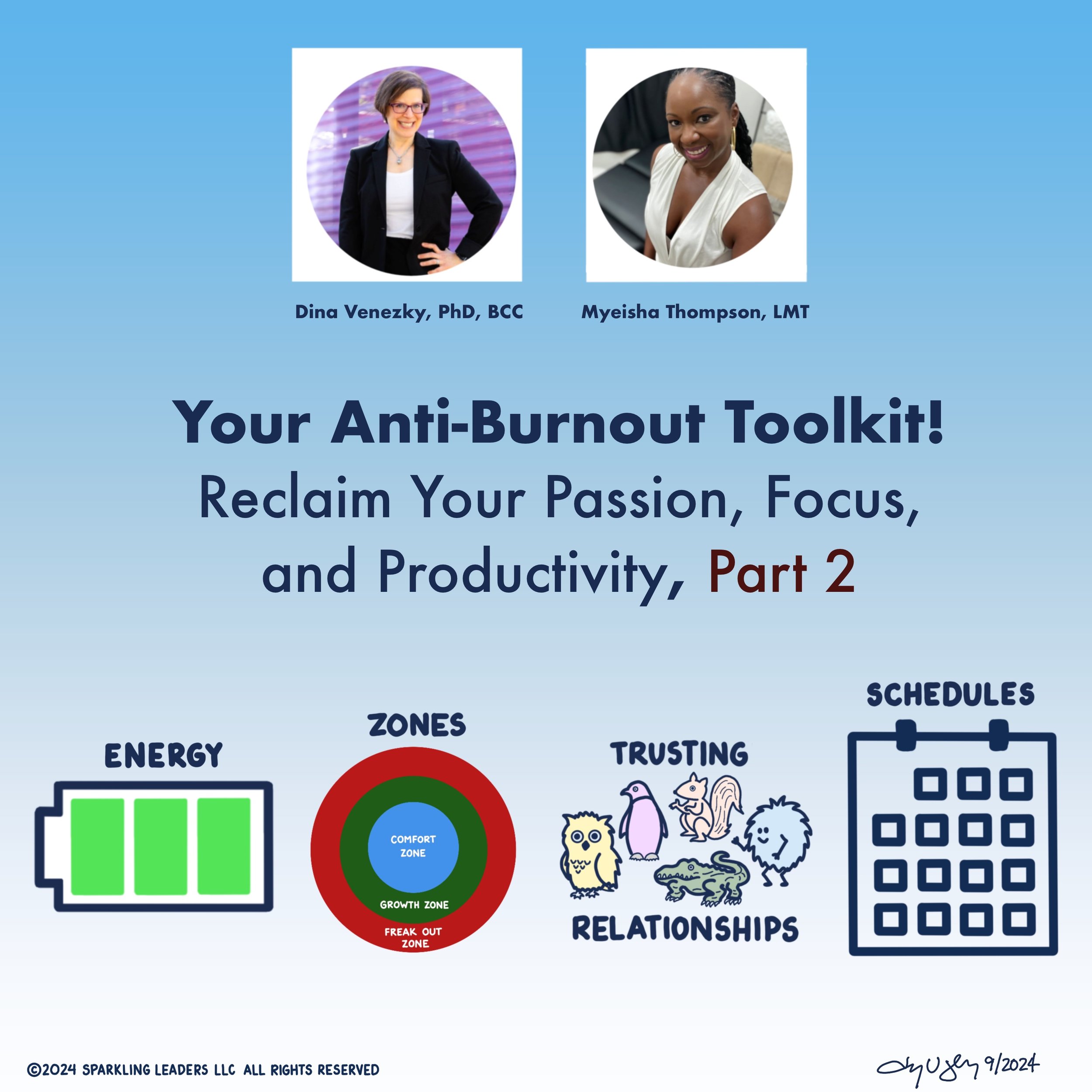Be Proactive To Prevent Burnout
By Dina Venezky, PhD, BCC, and Myeisha Thompson, LMT, author of Through You To You: Stepping Out of Anxiety and Depression & Into the Next Version of You and owner of Amani Massage and Wellness
Part 2: Be proactive to maintain your wellness
While burnout may cause challenges like brain fog, indecision, or lack of energy for some, for others, it may look like snapping at your spouse or general irritability with everyday situations. However burnout shows up for you, know that the most successful entrepreneurs and professionals adopt strategies to maintain their wellness.
In part two of this series, we're examining ways to build resilience for the future. As in the first part, each section provides a brief overview along with immediate action steps to stop the downward spiral.
In part two, we explore long-term strategies and lifestyle changes that can help you build resilience including how to:
Recognize what drains and fills your energy
Notice your comfort, growth, and freak-out zones
Prioritize time to connect with those who support you
Pad your calendar to get the most out of travel and big events
See part one to learn more about identifying your unique combination of burnout symptoms. We discussed how to:
Recognize your personal symptoms of overwhelm
Permit yourself to say no
Use your body to reduce tension in the moment
Whether you’re noticing signs of burnout or looking for ways to avoid it, this guide offers practical, actionable advice to help you reclaim your passion, focus, and productivity.
How To Be Proactive About Preventing Burnout
#1 Recognize what drains and fills your energy
It’s natural to have energy fluctuations throughout the day. Knowing what tasks energize and what tasks require additional energy can help you plan and improve your well-being. Imagine if you could create your perfect week where your energy matched all your tasks.
Consider the following reflection questions.
How aware are you of your energy levels throughout the day?
Are you aware of the energy required for the different tasks you face?
What times of the day are easiest for you to get individual work done?
What times of the day are best for you to work with others?
When do you benefit most from sleep, exercise, and food?
What types of activities do you do when your energy is low?
Regardless of where you are on your journey, understanding your energy levels and making small changes to your schedule can lead to a big impact.
Action step:
Do an energy audit!
Set a timer to notice where your energy is on a scale of 0 (can’t move) to 10 (energy is my superpower) throughout the day.
Record the time, what you were doing, and your number for a few days.
Reflect on your focus for low-energy activities. Is it on something you control?
Do your recordings match your expectations?
Is there anything you notice that can help you with planning for the future?
Sometimes being aware of our energy state is enough to help us move out of it.
Additional action step, For those who can control items on their calendar:
Schedule your calendar based on your energy needs. (See Action Step #4 for help scheduling big events).
Based on your energy audit, note times that work best for you for certain activities.
Protect non-meeting time to advance on your goals.
Prior to adding something to your calendar, reflect on not only your time but also your energy availability.
You can beat burnout by regularly assessing your commitments. Look for low-priority or draining tasks that you can potentially eliminate or delegate.
#2 Know your comfort, growth, and freak-out zones
Are you excited to try new things or do you prefer the status quo?
Does your level of overwhelm influence your answer?
Understanding your comfort, growth, and freak-out zones is crucial for personal growth and well-being. An easy way to determine what zone you are in is to reflect on how you are feeling.
Comfort Zone: Feeling safe and in control.
Growth Zone: Feeling curious, open to new experiences, and willing to learn.
Freak-out Zone: Feeling fear, overwhelm, and anxiety.
It's common to feel enthusiastic when scheduling new activities, only to find yourself hesitant when you need to do them.
Venturing outside your comfort zone requires more mental and emotional energy, especially the first time you do something new.
Know your strengths and what you enjoy to help reduce overwhelm and allow for growth.
Expand your comfort zone gradually and sustainably by trying new things in a safe environment with people you trust and work well with.
Action Steps:
Map your comfort, growth, and freak-out zones.
Comfort Zone: Record a few activities that feel safe and require minimal effort.
Growth Zone: Record a few activities that require a comfortable amount of effort where you are acquiring a new skill.
Freak-out Zone: Record a few activities that bring a sense of fear or anxiety.
Reflect on past zones.
What types of things worried you the most when you were a child?
Pick one of the things that no longer worries you.
What did you do to move it from the freak-out zone?
How can you use this knowledge to help you?
Turn knowledge into action.
Celebrate the things you do in your growth zone.
If there is something you need to do that is in your freak-out zone, what small step could you take in your growth zone?
Notice how small steps can help you expand your comfort zone.
#3 Prioritize time with those who support you
Knowing who you can count on for support is crucial for both personal and professional growth. Just as corporate boards guide companies, your personal board helps steer you toward your goals and through life's challenges.
Board members play different roles. Different people might help you dream bigger, stay grounded, celebrate successes, or boost your confidence.
Not everyone needs an official mentor. Consider how peers, friends, family members, or colleagues who align with your values and aspirations can help.
Think about how often you want to connect and prioritize time with individuals on your board. Regular interactions with your support network can provide fresh perspectives, emotional resilience, and opportunities for growth that you might miss when solely focused on tasks.
Action Step:
Map out your board
Write down at least one person who provides the following for you: honest feedback, emotional support, encouragement, goal-setting, accountability
Does your board include people from different areas of your life? If not, is there anyone else you can think of who might have a different perspective?
Relationships require nurturing. Schedule time to check in with each board member. We recommend interacting with at least one member of your board each week.
Be intentional about your time to maintain and deepen these connections. Your investment in your support system will provide the foundation for your personal and professional development.
Bonus #4: Pad your calendar to get the most out of travel/big events
Do you ever schedule something when your calendar is wide open and then when the event arrives, your calendar is packed?
It’s easy to overschedule your future self.
How do you feel when you look at your calendar for the current week.
How do you feel when you look at a week several months in the future?
How can you use this information when planning for the future?
Action step:
Pad your calendar
When scheduling travel, big meetings, or anything outside of your growth zone, pad your calendar with prep and recovery time.
Consider naming your prep and recovery time something like, “Important Meeting” to help protect the time.
Test out different amounts of padding to determine what is most helpful for you for each situation. The goal is to give yourself the space to be the person you want to be.
Remember to schedule time to unpack and process information from important events.
If you need to work through the weekend, where else can you schedule recovery time?
Take care of your best self by scheduling recovery time.

